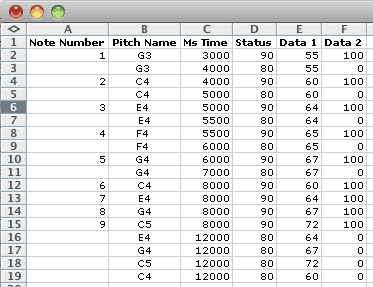
Here's a reference page that will help you identify MIDI note numbers. Remember, middle C is always MIDI note number 60.
http://piano.about.com/library/Pitch-Notation/bl_MIDI-Pitch-Notation_2.htm (this page calls Middle C, C4)
Here's a short musical example to illustrate the MIDI messages needed to play these nine notes. You'll work in chronological millisecond time at a tempo of 60 beats per minute which makes a quarter note equal to 1000 ms. Note number two is middle C, or C4, or MIDI note number 60. The other MIDI note numbers are calculated from there based on the number of half steps away from 60.

There are five single notes followed by a four note chord. This short example requires 18 MIDI messages.

Every note requires two messages: one to turn it on (NON) and one to turn it off (NOF).
Status bytes are hex values, all other numbers are decimal.
Status 90 is a NON.
Status 80 is a NOF.
Use the NOF status byte with a velocity of 0 to turn the note off. Velocity is ignored with $8n, but use zero.
Because the tempo is 60, every quarter note lasts 1000 ms.
You have two choices for the starting time of the first beat of the first measure, 0 ms or 1000 ms. Take your pick.
The song does not begin on the first beat of measure one, it begins on beat 4.
The elapsed time between the NON and its subsequent NOF message determines the note's duration.
The example set the velocity of all NON messages to 100. It's boring but good for a rough draft.
A chord is be played by sending multiple MIDI messages using the same time stamp.
The notes of the chord can be turned on or off in any order.
Make sure every NON has a matching NOF. Matching means same MIDI channel and same MIDI note number.
Revised John Ellinger, January - September 2013